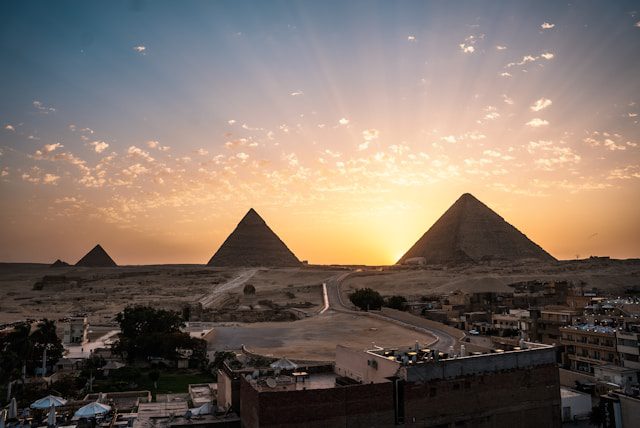Forget everything you learned in history class—seriously. A shocking new claim says the Giza pyramids might not just be 4,500 years old… but closer to 38,000. Oh, and there’s allegedly a massive underground city sitting beneath them. If this turns out to be true, it’s not just a history update—it’s a full system reboot.
But before you toss your textbooks in the Nile, let’s separate fact from fiction, hype from hard evidence, and get to the bottom of what this discovery really means for science, archaeology, and your next conspiracy-fueled podcast binge.
What Did the Researchers Claim?
A 2025 bombshell report dropped by Italian and Scottish researchers, including Professor Corrado Malanga (University of Pisa) and Filippo Biondi (University of Strathclyde), claims to have used advanced radar and seismic tech to detect:
-
Shafts descending over 2,100 feet beneath the Khafre Pyramid
-
Chamber-like structures stretching even deeper, possibly over 4,000 feet
-
Evidence of a lost underground city potentially called Amenti, mentioned in Egyptian Book of the Dead (Chapter 149)
They say this isn’t just natural rock. This is geometry, order, and engineering—on a level we can’t even match today with modern tools.
Is This Really 38,000 Years Old?
That’s the shocker. The team ties the age of these structures to the Younger Dryas impact hypothesis, a fringe theory suggesting a global flood or comet impact wiped out an earlier advanced civilization about 12,800 years ago.
This would predate Göbekli Tepe, the world’s oldest known megalithic site (estimated at 11,500 years old), by a whopping 26,500 years. If true, it nukes the entire mainstream timeline of human civilization.
The Smoking Gun: Water Damage and Salt Crusts?
Lead researcher Mei claims:
“Some blocks near the Great Pyramid’s entrance show clear signs of water erosion… Salt encrustations inside the chambers support the idea they were once submerged.”
Salt layers up to half an inch thick were also noted by 19th-century explorers like W.M. Flinders Petrie and Colonel Howard Vyse in both the King’s and Queen’s chambers.
Water… inside the Great Pyramid? If this was Atlantis, it’s giving soggy real estate vibes.
But Not Everyone’s Buying It
Dr. Zahi Hawass, former Egyptian Minister of Antiquities (and no stranger to pyramid drama), slammed the discovery:
“These radar methods are not scientifically validated. There’s no proof of underground cities. This is fake archaeology.”
Radar specialist Professor Lawrence Conyers (University of Denver) echoed the criticism:
“Structures 2,000 feet deep? That’s fantasy. People 38,000 years ago were living in caves, not building megastructures.”
So, we’ve got ancient text believers vs. mainstream science. Not exactly a new feud, but this one’s got fresh tech, newer claims, and better PR.
What the Evidence Actually Shows
Let’s zoom out. What’s truly been discovered?
-
Anomalies below the pyramid confirmed by seismic and Doppler radar scans
-
No peer-reviewed publication yet—meaning no verification from the broader scientific community
-
The tech used is experimental, not part of standard archaeological methodology
It’s one thing to find anomalies. It’s another to rewrite history books based on them.
Why It Matters (Even If It’s Not All True)
Even if only 10% of the claims hold water (pun intended), it could:
-
Force new excavations beneath Giza using updated tech
-
Pressure Egypt’s Ministry of Antiquities to grant permits for deep drilling or open new shafts
-
Renew interest in ancient texts once dismissed as myth
It also puts pressure on the global archaeological community to re-examine assumptions—especially about what kind of knowledge existed before written history.
FAQs: What You Really Want to Know
Q: Is there hard proof of a city beneath the pyramids?
Not yet. Radar and acoustic scans suggest underground anomalies, but there’s no published excavation or imaging of an actual city.
Q: Why hasn’t this been peer-reviewed?
The data hasn’t been submitted to major archaeological journals. Until that happens, it’s still speculative.
Q: Could this discovery change how we date the pyramids?
Only if the data holds up under peer review and additional physical evidence is found. Until then, the mainstream 4,500-year estimate remains the standard.
Q: Is this tied to the Atlantis myth?
The “Amenti” city theory overlaps with legends of lost civilizations like Atlantis—but there’s no direct link beyond mythological similarities.
Q: What’s next?
Expect increased scrutiny, media coverage, and maybe even excavation proposals if political and scientific barriers are overcome.
History Rewrite or Hype Job?
Let’s be clear—this could be one of the biggest discoveries of the century… or another case of wishful pseudoscience dressed up in scientific lingo.
But even the skepticism has value. It pushes science to evolve, tech to improve, and ancient Egypt to remain what it’s always been: one of the most magnetic enigmas in human history.
The truth? Buried—literally and metaphorically. And until someone digs deeper with hard science, it’ll stay that way.
Want More Like This?
Bookmark this. Share it. Argue about it. And next time someone says “we know everything about the pyramids,” hit them with: “Yeah? Prove there’s not a 38,000-year-old city under your feet.”












Leave a Reply